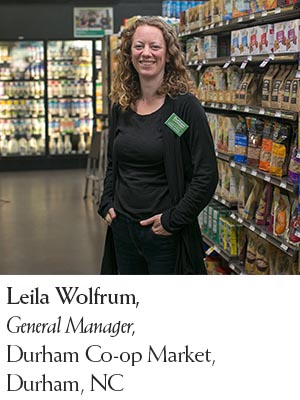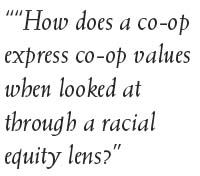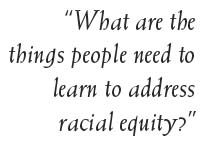
If you were to ask, most people would say that they are against racism and intolerance. Yet our society has imposed many powerful economic and social barriers to those from disenfranchised racial and economic backgrounds. Most people live in separate spheres and have limited interactions with different races and classes. For nearly a generation, food co-ops have attracted mostly white, educated and affluent people. Although everyone is ostensibly welcome to patronize a food co-op, there are deterrents to shopping at one, and some of them are social and economic—the same barriers that plague society at large.
Many food co-ops today are starting to grapple with their overwhelmingly white identities and look for ways to do more than just make a statement about inclusion. They are beginning to ask, what does it look like when a food co-op or other organization wants to actively embrace diversity, inclusion and equity in their operations? What are the things a co-op could do to prepare the organization to address these issues systematically and respectfully?
With anything co-op related, starting with a look at the Cooperative Principles and Values can be a good beginning. The organizational values that guide co-ops are very much in alignment with tolerance and racial equity. Four values are especially relevant: equality, equity, solidarity and caring for others. Organizational values often guide operational decisions. How does a co-op express these co-op values when looked at through a racial equity lens? Where is it succeeding, where is it falling short?
Moving toward intentional action first requires dialogue and reflection. If the food co-op wants to move beyond broad inclusivity statements toward acting to achieve racial equity, getting people together to discuss why it’s important is vital. Why does the co-op want to do this work? Leaders would also need to examine for themselves as individuals why they would want to participate in changing certain organizational dynamics. There are lots of great reasons to consider it, including a moral imperative, addressing bias, the desire for innovation and improvement, to foster leadership at the co-op, as well as to increase the co-op’s community impacts by reaching more people and growing sales. These are highly motivating goals, but the work can still be very difficult at times. How strongly do individuals and the co-op feel about moving forward in these areas? Is there a real commitment to change?
 Chris Maher, general manager of BriarPatch Food Co-op in Grass Valley, Calif. said the co-op’s board and management team have begun to have those conversations at their co-op. One of the tools they’ve used to help springboard discussion is the CDS Consulting Co-op’s booklet Everyone Welcome? Personal Narratives About Race and Food Co-ops. “People really related to the personal stories. It hooked people,” Maher said. “The whole book offers a variety of topics germane to issues of diversity. Everyone Welcome? has a personal side and we used that framing as a go-round for discussion. We asked each other what was challenging for you? What has been your own experience, was it different or similar?”
Chris Maher, general manager of BriarPatch Food Co-op in Grass Valley, Calif. said the co-op’s board and management team have begun to have those conversations at their co-op. One of the tools they’ve used to help springboard discussion is the CDS Consulting Co-op’s booklet Everyone Welcome? Personal Narratives About Race and Food Co-ops. “People really related to the personal stories. It hooked people,” Maher said. “The whole book offers a variety of topics germane to issues of diversity. Everyone Welcome? has a personal side and we used that framing as a go-round for discussion. We asked each other what was challenging for you? What has been your own experience, was it different or similar?”
Maher noted that one of the issues that came up for BriarPatch was that their co-op is in a community that is 92% white. Not everyone in the community feels like they have a problem with diversity because it is so homogenous. “Asking the question, ‘is this a priority’ is actually a complete marginalization of whole groups of people, even if seems like an innocuous question,” he said. But this fall, on the very night the board was meeting to talk about race at their food co-op, a local black boy was harassed by a group of whites in Grass Valley, calling him the ‘N’ word while nobody stood up to help him. It was a timely and galvanizing moment for the community. “People who are white and privileged sometimes are not looking or even seeing racial difference as an issue. This really horrible event made people realize this is a thing we need to pay attention to.”
As BriarPatch continues to have these conversations at the co-op, Maher said that they’ve also begun the process of reaching out to community groups to do more events, trainings and discussions. “We’re realizing that small actions can build up into more meaningful collaborative culture change at the co-op. The board is also proud to show leadership in this area and be part of thinking about this as an integral part of the organization.”
 Some food co-ops have found that self-assessment of the co-op’s culture would be a next good step to answering some of those questions. What are the things people need to learn to address racial equity? Testing the level of implicit bias in an organization can be important. It can help with starting crucial conversations and getting people to think about their role or potential impact. At Seward Community Co-op in Minneapolis, their co-op leaders participated in an Intercultural Development Inventory (IDI) to assess their cultural attitudes. The IDI helps organizations with understanding 5 stages of cultural difference, including polarity, denial, minimization, acceptance and adaptation. Elizabeth Liddiard Wozniak, the co-op’s human resources manager said that “It was a driver for raising awareness.”
Some food co-ops have found that self-assessment of the co-op’s culture would be a next good step to answering some of those questions. What are the things people need to learn to address racial equity? Testing the level of implicit bias in an organization can be important. It can help with starting crucial conversations and getting people to think about their role or potential impact. At Seward Community Co-op in Minneapolis, their co-op leaders participated in an Intercultural Development Inventory (IDI) to assess their cultural attitudes. The IDI helps organizations with understanding 5 stages of cultural difference, including polarity, denial, minimization, acceptance and adaptation. Elizabeth Liddiard Wozniak, the co-op’s human resources manager said that “It was a driver for raising awareness.”
Part of the goal in using a tool like IDI or other tools to identify and test implicit bias is to arrive at a shared definition of equity. Part of that process is asking people: what does equity mean to you? And it’s important to note that race is one aspect of diversity within an organization, which could include ethnic distinctions, income disparities, sexual preference, gender and religious differences.
Creating a team focused on equity will help cooperatives stay focused on their values. An equity team could evaluate and make recommendations on several co-op operational systems through a racial equity lens, including:
- Co-op policies
- Hiring practices
- Co-op education
- Training and advancement opportunities
In her newsletter article about Seward Community Co-op’s building of a second store in an historically African-American neighborhood, “Road to Friendship: A Food Co-op in a Community of Color,” LaDonna Sanders-Redmond, diversity and community engagement manager wrote, “The cooperative had to deliberately tackle its unconscious bias in the hiring process. The leadership began an intense process of gaining cultural competency, and this work led to the development of diversity goals for construction and store hiring.”
Education and training are particularly important for helping organizations build capacity for institutional change. In this issue’s case study, Durham Co-op Market in Durham, North Carolina, made education and training a priority at the co-op to create the kind of inclusive co-op culture that they sought. Leadership and advancement opportunities for everyone demonstrate a strong commitment to equity as well as contribute to an atmosphere of continual improvement.
 In addition, Durham Co-op Market also believes it is important to welcome the whole community, to engage people in essential conversations, and listen to their feedback. As a result, the Durham Co-op Market launched a Food for All program supported by roundup dollars at the cash register—those who can afford to donate support those who need assistance, a key aspect of equitability—and they hold a community dinner night once a week focused on accessible, good real food. They continue to engage with the community to understand how the co-op can best be of service to a variety of people in the community, and Leila Wolfrum, the co-op’s general manager, believes that service orientation is what it means to be an equitable business.
In addition, Durham Co-op Market also believes it is important to welcome the whole community, to engage people in essential conversations, and listen to their feedback. As a result, the Durham Co-op Market launched a Food for All program supported by roundup dollars at the cash register—those who can afford to donate support those who need assistance, a key aspect of equitability—and they hold a community dinner night once a week focused on accessible, good real food. They continue to engage with the community to understand how the co-op can best be of service to a variety of people in the community, and Leila Wolfrum, the co-op’s general manager, believes that service orientation is what it means to be an equitable business.
Food co-ops, through co-op values and the products they sell, are also called to demonstrate and promote equity in many ways. Currently, the food system is broken. Agribusiness controls 83% of all food produced in the marketplace, squeezing out small farmers and other marginalized groups through lack of government subsidies and land-buyouts. People of color are twice as likely as whites to be employed in low wage food service jobs. So how does the co-op address the need for equity among farmers, workers and consumers? How does it ensure that everyone has access to healthy food if they want it, and what is it doing to support this vision? Whether a co-op and its leaders decide to address internal racial equity, or to focus on the racial inequities within the larger food system, all this work is important and can have a positive impact on our local, regional, national and global communities.
For articles and resources focused on racial equity and inclusivity we have published in the past year, visit the online CDS Consulting Co-op Library.
https://library.columinate.coop/everyone-welcome-considering-race-and-food-co-ops/
https://library.columinate.coop/everyone-welcome-personal-narratives/
https://library.columinate.coop/location-location-location-part-2/
https://library.columinate.coop/new-north-willy-street-co-op-serves-needs-and-values/
https://library.columinate.coop/reflecting-ends-and-implementing-inclusivity-practices/
Have more questions?
Get in touch with one of our consultants.


